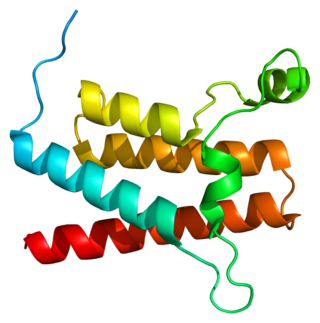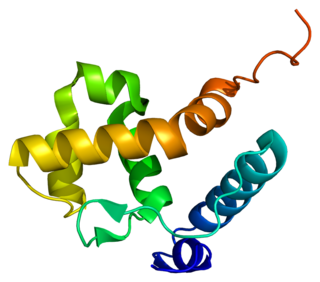Related Research Articles

A nucleosome is the basic structural unit of DNA packaging in eukaryotes. The structure of a nucleosome consists of a segment of DNA wound around eight histone proteins and resembles thread wrapped around a spool. The nucleosome is the fundamental subunit of chromatin. Each nucleosome is composed of a little less than two turns of DNA wrapped around a set of eight proteins called histones, which are known as a histone octamer. Each histone octamer is composed of two copies each of the histone proteins H2A, H2B, H3, and H4.

In molecular biology, SWI/SNF, is a subfamily of ATP-dependent chromatin remodeling complexes, which is found in eukaryotes. In other words, it is a group of proteins that associate to remodel the way DNA is packaged. This complex is composed of several proteins – products of the SWI and SNF genes, as well as other polypeptides. It possesses a DNA-stimulated ATPase activity that can destabilize histone-DNA interactions in reconstituted nucleosomes in an ATP-dependent manner, though the exact nature of this structural change is unknown. The SWI/SNF subfamily provides crucial nucleosome rearrangement, which is seen as ejection and/or sliding. The movement of nucleosomes provides easier access to the chromatin, allowing genes to be activated or repressed.
Chromatin remodeling is the dynamic modification of chromatin architecture to allow access of condensed genomic DNA to the regulatory transcription machinery proteins, and thereby control gene expression. Such remodeling is principally carried out by 1) covalent histone modifications by specific enzymes, e.g., histone acetyltransferases (HATs), deacetylases, methyltransferases, and kinases, and 2) ATP-dependent chromatin remodeling complexes which either move, eject or restructure nucleosomes. Besides actively regulating gene expression, dynamic remodeling of chromatin imparts an epigenetic regulatory role in several key biological processes, egg cells DNA replication and repair; apoptosis; chromosome segregation as well as development and pluripotency. Aberrations in chromatin remodeling proteins are found to be associated with human diseases, including cancer. Targeting chromatin remodeling pathways is currently evolving as a major therapeutic strategy in the treatment of several cancers.

Transcription activator BRG1 also known as ATP-dependent chromatin remodeler SMARCA4 is a protein that in humans is encoded by the SMARCA4 gene.

Probable global transcription activator SNF2L2 is a protein that in humans is encoded by the SMARCA2 gene.

Actin-like protein 6A is a protein that in humans is encoded by the ACTL6A gene.

AT-rich interactive domain-containing protein 1A is a protein that in humans is encoded by the ARID1A gene.

SWI/SNF-related matrix-associated actin-dependent regulator of chromatin subfamily E member 1 is a protein that in humans is encoded by the SMARCE1 gene.

SWI/SNF complex subunit SMARCC2 is a protein that in humans is encoded by the SMARCC2 gene.

AT-rich interactive domain-containing protein 1B is a protein that in humans is encoded by the ARID1B gene. ARID1B is a component of the human SWI/SNF chromatin remodeling complex.

SWI/SNF-related matrix-associated actin-dependent regulator of chromatin subfamily D member 1 is a protein that in humans is encoded by the SMARCD1 gene.

The Chromodomain-Helicase DNA-binding 1 is a protein that, in humans, is encoded by the CHD1 gene. CHD1 is a chromatin remodeling protein that is widely conserved across many eukaryotic organisms, from yeast to humans. CHD1 is named for three of its protein domains: two tandem chromodomains, its ATPase catalytic domain, and its DNA-binding domain.

Protein polybromo-1 (PB1) also known as BRG1-associated factor 180 (BAF180) is a protein that in humans is encoded by the PBRM1 gene.

Structural maintenance of chromosomes protein 5 is a protein encoded by the SMC5 gene in human.

SWI/SNF-related matrix-associated actin-dependent regulator of chromatin subfamily D member 2 is a protein that in humans is encoded by the SMARCD2 gene.
ISWI is one of the five major DNA chromatin remodeling complex types, or subfamilies, found in most eukaryotic organisms. ISWI remodeling complexes place nucleosomes along segments of DNA at regular intervals. The placement of nucleosomes by ISWI protein complexes typically results in the silencing of the DNA because the nucleosome placement prevents transcription of the DNA. ISWI, like the closely related SWI/SNF subfamily, is an ATP-dependent chromatin remodeler. However, the chromatin remodeling activities of ISWI and SWI/SNF are distinct and mediate the binding of non-overlapping sets of DNA transcription factors.
Reptin is a tumor repressor protein that is a member of the ATPases Associated with various cellular Activities (AAA+) helicase family and regulates KAI1. Desumoylation of reptin alters the repressive function of reptin and its association with HDAC1. The sumoylation status of reptin modulates the invasive activity of cancer cells with metastatic potential. Reptin was reported in 2010 to be a good marker for metastasis. Another name for reptin, RuvB-like 2 comes from its similarity to RuvB, an ATP-dependent helicase found in bacteria. Reptin is highly conserved, being found in yeast, drosophila, and humans. It presents itself as a member of a number of different protein complexes, most of which function in chromatin modification, including PRC1, TIP60/NuA4 and INO80. Hence, it also has the names INO80J, TIP48, and TIP49B. In the majority of its functions, reptin is paired with a very similar protein, pontin (RUVBL1).
Nucleosome Remodeling Factor (NURF) is an ATP-dependent chromatin remodeling complex first discovered in Drosophila melanogaster that catalyzes nucleosome sliding in order to regulate gene transcription. It contains an ISWI ATPase, making it part of the ISWI family of chromatin remodeling complexes. NURF is highly conserved among eukaryotes and is involved in transcriptional regulation of developmental genes.
The INO80 subfamily of chromatin remodeling complexes are ATPases, and includes the INO80 and SWR1 complexes.
Robert E. Kingston is an American biochemist who studies the functional and regulatory role nucleosomes play in gene expression, specifically during early development. After receiving his PhD (1981) and completing post-doctoral research, Kingston became an assistant professor at Massachusetts General Hospital (1985), where he started a research laboratory focused on understanding chromatin's structure with regards to transcriptional regulation. As a Harvard graduate himself, Kingston has served his alma mater through his leadership.
References
- 1 2 3 4 5 6 7 8 9 Cairns BR, Lorch Y, Li Y, Zhang M, Lacomis L, Erdjument-Bromage H, et al. (December 1996). "RSC, an essential, abundant chromatin-remodeling complex". Cell. 87 (7): 1249–60. doi: 10.1016/S0092-8674(00)81820-6 . PMID 8980231.
- ↑ Clapier CR, Iwasa J, Cairns BR, Peterson CL (July 2017). "Mechanisms of action and regulation of ATP-dependent chromatin-remodelling complexes". Nature Reviews. Molecular Cell Biology. 18 (7): 407–422. doi:10.1038/nrm.2017.26. PMC 8127953 . PMID 28512350.
- 1 2 Tang L, Nogales E, Ciferri C (June 2010). "Structure and function of SWI/SNF chromatin remodeling complexes and mechanistic implications for transcription". Progress in Biophysics and Molecular Biology. 102 (2–3): 122–8. doi:10.1016/j.pbiomolbio.2010.05.001. PMC 2924208 . PMID 20493208.
- ↑ Smith CL, Horowitz-Scherer R, Flanagan JF, Woodcock CL, Peterson CL (February 2003). "Structural analysis of the yeast SWI/SNF chromatin remodeling complex". Nature Structural Biology. 10 (2): 141–5. doi:10.1038/nsb888. PMID 12524530.
- 1 2 Shim EY, Ma JL, Oum JH, Yanez Y, Lee SE (May 2005). "The yeast chromatin remodeler RSC complex facilitates end joining repair of DNA double-strand breaks". Molecular and Cellular Biology. 25 (10): 3934–44. doi:10.1128/mcb.25.10.3934-3944.2005. PMC 1087737 . PMID 15870268.
- 1 2 Chai B, Huang J, Cairns BR, Laurent BC (July 2005). "Distinct roles for the RSC and Swi/Snf ATP-dependent chromatin remodelers in DNA double-strand break repair". Genes & Development. 19 (14): 1656–61. doi:10.1101/gad.1273105. PMC 1176001 . PMID 16024655.
- 1 2 3 4 Lia G, Praly E, Ferreira H, Stockdale C, Tse-Dinh YC, Dunlap D, et al. (February 2006). "Direct observation of DNA distortion by the RSC complex". Molecular Cell. 21 (3): 417–25. doi:10.1016/j.molcel.2005.12.013. PMC 3443744 . PMID 16455496.
- 1 2 3 Hopson S, Thompson MJ (October 2017). "BAF180: Its Roles in DNA Repair and Consequences in Cancer". ACS Chemical Biology. 12 (10): 2482–2490. doi:10.1021/acschembio.7b00541. PMID 28921948.
- ↑ "RSC6 | SGD". www.yeastgenome.org. Retrieved 2020-03-31.
- ↑ Tuoc TC, Boretius S, Sansom SN, Pitulescu ME, Frahm J, Livesey FJ, Stoykova A (May 2013). "Chromatin regulation by BAF170 controls cerebral cortical size and thickness". Developmental Cell. 25 (3): 256–69. doi: 10.1016/j.devcel.2013.04.005 . hdl: 11858/00-001M-0000-0013-F327-3 . PMID 23643363.
- ↑ DelBove J, Rosson G, Strobeck M, Chen J, Archer TK, Wang W, et al. (December 2011). "Identification of a core member of the SWI/SNF complex, BAF155/SMARCC1, as a human tumor suppressor gene". Epigenetics. 6 (12): 1444–53. doi:10.4161/epi.6.12.18492. PMC 3256333 . PMID 22139574.